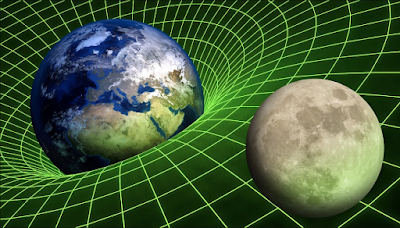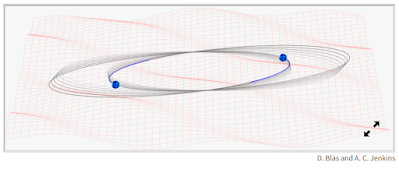Precise measurements of the Earth-Moon distance can allow researchers to estimate the maximum possible amplitude of the steady background “hum” of gravitational waves.
The barrage of all gravitational waves that continuously hit Earth in the microhertz frequency range roughly one oscillation every few weeks might be detected by measuring their subtle effects on the Earth-Moon system. By exploiting this decades-old idea, researchers have now shown that the latest laser ranging data could be used to place a significantly smaller upper limit on the possible strength of these waves, compared with previous estimates. The technique promises a powerful new way to probe gravitational waves by using natural orbital systems as sensitive detectors.
Gravitational waves can provide information about some of the most violent events in the Universe, from black hole mergers to the big bang, yet current detectors have a blind spot between two distinct frequency bands. The LIGO-Virgo-KAGRA collaboration—based on laser interferometers located in the US, Europe, and Japan—can detect waves with frequencies in the range of 1 to 1000 Hz. Another detection scheme uses periodic signals from pulsars to detect nanohertz (nHz) gravitational waves, corresponding to one oscillation every few years. So there is a big gap for waves in the microhertz ( μHz) regime, which could be generated, for example, by supermassive black hole binary pairs in the late stages of orbiting each other before merging.
“We’re aiming to fill this gap,” says Alexander Jenkins of University College London. “The idea is to measure how [the waves] influence the orbits of binary systems, including the Earth-Moon system,” Jenkins says that many researchers have helped to develop this idea since the 1970s. In the simplest case, a continuous gravitational wave with the same frequency as the orbital motion could, say, nudge the objects a bit closer together in each cycle. Through this resonance phenomenon, the orbit would change over time in a way that reflects the wave’s properties.
Never a calm moment. If two gravitationally bound objects are continuously buffeted by gravitational waves from throughout the Universe, their mutual orbit will gradually change over time.
In 2013, Lam Hui of Columbia University and colleagues showed that gravitational waves in the μHz frequency range could have a potentially measurable effect on binary systems. They demonstrated theoretically that a continuous background from a large number of such waves coming from all directions should cause the period and other orbital parameters to undergo a random walk and thus to change gradually over time. The rate of change would reflect the strength of the prevailing waves.
Using data from a binary pulsar an orbiting pair of pulsar stars, which emit periodic signals Hui and colleagues obtained an upper bound on the possible strength of gravitational waves in the μHz gap. Now, Jenkins and Diego Blas of the Autonomous University of Barcelona, Spain, have taken this work further, showing that the accuracy of current data on the Earth-Moon system should allow researchers to derive an upper bound that is much smaller than that derived by Hui and his colleagues.
Jenkins and Blas build on earlier work to develop a mathematical formalism, as well as numerical methods, to follow the random evolution of the orbital motion of any binary system subject to a background of gravitational waves. These mathematical techniques allowed them to make a more precise link between orbital changes and the nature of the gravitational waves driving them. “Our formalism gives a much more complete and rigorous way to calculate all of the effects that a gravitational-wave background would have on a given binary system,” Jenkins says.
In a companion paper, the researchers use these methods to propose a pathway to lowering the bound on the strength of the gravitational-wave background in the current “blind spot”. This can be done, they argue, by using laser-ranging measurements of the Moon to determine precise changes in the Earth-Moon orbit and then comparing these with the predictions of the theory. The results, according to their estimates, should improve researchers’ knowledge of the possible amplitude of these waves by more than 100 times.
“This is an exciting and novel way of seeing gravitational waves,” says black hole physicist Vitor Cardoso of the Instituto Superior Técnico, Lisbon, Portugal. “The idea is simple, but it requires difficult calculations to implement and show that it works.” Moreover, this alternative approach to detection could reveal unexpected gravitational-wave sources, he says. We may find “that the Universe is full of mysterious gravitational-wave content.”
Regarding the next steps, Jenkins believes that more theoretical work is needed. For example, “it's not just individual binary systems we also need to see how entire galaxies respond to gravitational waves,” he says.
References
1. D. Blas and A. C. Jenkins, “Detecting stochastic gravitational waves with binary resonance,” Phys. Rev. D 105, 064021 (2022).
2. D. Blas and A. C. Jenkins, “Bridging the μHz gap in the gravitational-wave landscape with binary resonances,” Phys. Rev. Lett. 128, 101103 (2022).
3. L. Hui et al., “Binary systems as resonance detectors for gravitational waves,” Phys. Rev. D 87, 084009 (2013).




















